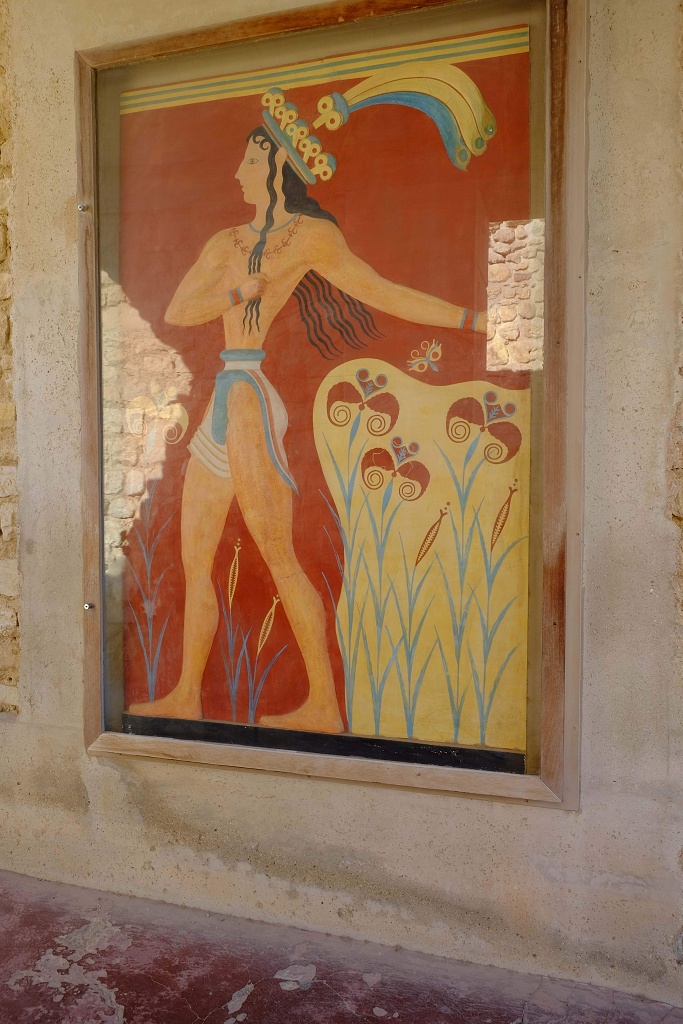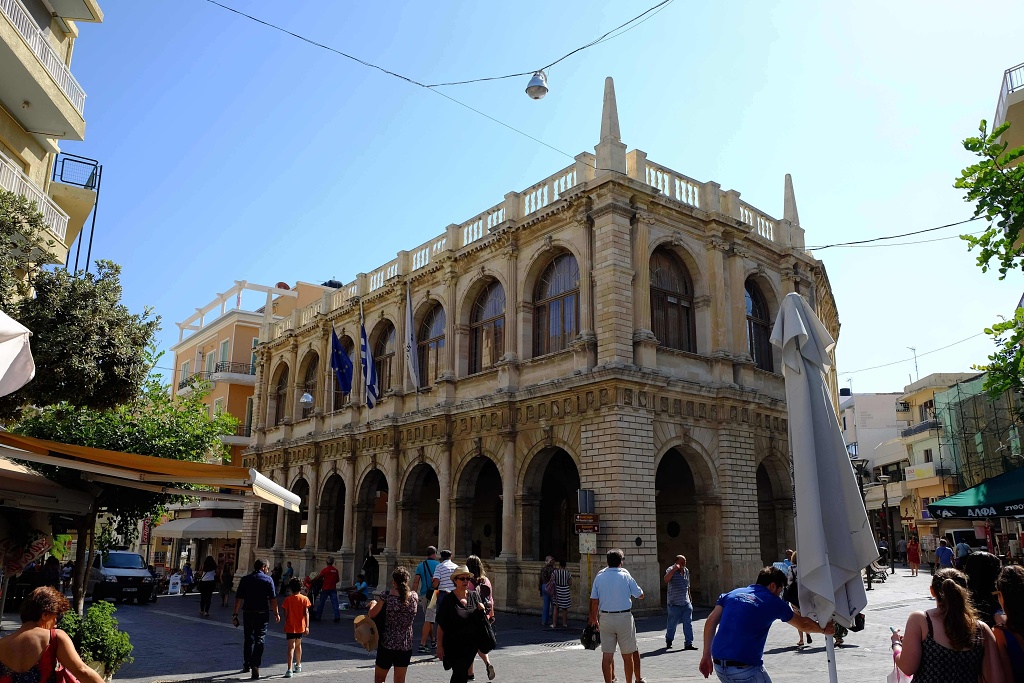Our trip from Rhodes to Crete is not uneventful, but in a good way. The crew cooked up a BBQ with entertainment on what could be termed the Lido deck, aka, outside in the fresh sea air. I opted for this instead of a regular dinner in the dining room. (Who would choose a stuffy, staid dining room to BBQ steak and chicken outside in the fresh air with entertainment thrown in to boot.) With a full belly I retire to my cabin. When I wake up to get ready for the tour of Crete I see we have already docked at the port.
We dock at the port city of Iroklio, also called Heraklion, to tour an ancient site and around the city itself. Crete has a longer history than most of the islands because it was the center of the Minoan civilization, which predates the Greek civilization. We know some history of the Minoans but, unfortunately, we cannot read any of the writings this culture left behind. We can read the hieroglyphics of Egypt because of the discovery of the Rosetta Stone. For those not familiar with the Rosetta Stone, it was a stone discovered in 1799 in Egypt. This stone had a decree inscribed on it in hieroglyphics, Demontic (an ancient Egyptian script) and Greek. Because of this we were now able to decipher the hieroglyphic and Demontic writings. Unfortunately, we have not discovered any such stone to decipher the Minoan language. Although the Minoans have vanished, they left behind the massive palace known as Knossos.
Crete itself was governed by several different countries over its history: the Romans, Venetians and the Turks to name a few. In World War II, Crete had the dubious distinction of being the first major land objective of size to be captured almost entirely by airborne forces. The German Fallschirmjägers (paratroopers) invaded the island in May of 1941. They succeeded in capturing the island, which was a first. However, this was accomplished with a large number of casualties which made Hitler vow that he would never again use his precious paratroopers in any such operation. (This is why the island of Malta, which was next on the list, was never invaded.) A memorial was erected in 1941 by Germany to commemorate the paratroopers who perished taking the island. It is located in a rural area 3 kilometers outside Chania. Only the pedestal of the monument remains today and has been engulfed by the expansion of Chania. German rule ended in 1945.
The cruise from Rhodes to Crete was made more enjoyable with on outdoor BBQ.
Chicken and steak cooked over charcoal never tasted so good.
Entertainment was provided by The Plug and Play Duo. Their forte was ABBA tunes.
These two youngsters just had to dance to the music.
With a belly full of steak and chicken, it was off to sleep. The morning begins early and will provide new adventures.
 In the morning it was off the ship, into buses and away we went. On the trip to our first stop we passed a bowling alley. Found it strange to see a bowling alley in Crete.
In the morning it was off the ship, into buses and away we went. On the trip to our first stop we passed a bowling alley. Found it strange to see a bowling alley in Crete.
 We arrived at a place that, from a quick glance, would be a pile of rocks.
We arrived at a place that, from a quick glance, would be a pile of rocks.
 However, our guide held a drawing depicting where we were really at.
However, our guide held a drawing depicting where we were really at.
 Welcome to the Palace of Knossos. Once a grand palace for the Minoan civilization, it is now, as with most ancient landmarks, a ruin.
Welcome to the Palace of Knossos. Once a grand palace for the Minoan civilization, it is now, as with most ancient landmarks, a ruin.
 We walk around almost in awe of the vastness of the palace. This is just looking across the palace grounds. The sheer size is nearly overwhelming.
We walk around almost in awe of the vastness of the palace. This is just looking across the palace grounds. The sheer size is nearly overwhelming.
 Some sections still retain the original colors they were painted so many centuries ago.
Some sections still retain the original colors they were painted so many centuries ago.
 The Minoan people must have been short considering the height of the different stories of the buildings as illustrated by the man on the balcony.
The Minoan people must have been short considering the height of the different stories of the buildings as illustrated by the man on the balcony.
 A throne room with its ancient wall art is only viewable from behind a barrier. The throne doesn’t look all that comfortable.
A throne room with its ancient wall art is only viewable from behind a barrier. The throne doesn’t look all that comfortable.
 This wall decoration is still mostly intact and now protected by plexiglass.
This wall decoration is still mostly intact and now protected by plexiglass.
 It is thought that ancient acrobats used these “horns” during their performances.
It is thought that ancient acrobats used these “horns” during their performances.
 Another ancient piece of decoration where you can see that it is a relief, i.e., this is not flat but has actual depth to it.
Another ancient piece of decoration where you can see that it is a relief, i.e., this is not flat but has actual depth to it.
 The immensity of the complex is what amazes visitors. It is said that in its day it was able to accommodate over 2,000 people.
The immensity of the complex is what amazes visitors. It is said that in its day it was able to accommodate over 2,000 people.
 More wall paintings: one of a dancer to the right and one of dolphins. Whatever was on the two panels below the dancer, have vanished with time.
More wall paintings: one of a dancer to the right and one of dolphins. Whatever was on the two panels below the dancer, have vanished with time.
 A storage area with storage jars intact.
A storage area with storage jars intact.
 But where you have a tourist attraction you have vendors. This one takes advantage of the myth of the Minotaur. It is said that it was the palace of Knossos that gave rise to the story of the Minotaur, the half man half bull monster.
But where you have a tourist attraction you have vendors. This one takes advantage of the myth of the Minotaur. It is said that it was the palace of Knossos that gave rise to the story of the Minotaur, the half man half bull monster.
 There is even a restaurant across the street from the entrance to the palace. Did not have time to eat there as I had to return to the bus and head for Heraklion.
There is even a restaurant across the street from the entrance to the palace. Did not have time to eat there as I had to return to the bus and head for Heraklion.
Heraklion is a bustling, cosmopolitan city. Our tour was headed to the historic center of town.
 We start at this beautiful fountain built by the Italians. At one time the Italians governed Crete.
We start at this beautiful fountain built by the Italians. At one time the Italians governed Crete.
 They also left their mark in the form of the buildings they left behind.
They also left their mark in the form of the buildings they left behind.
 This art gallery was once a Roman Catholic Church, the Basilica of St. Mark. Remember, the dominate religion is Greek Orthodox.
This art gallery was once a Roman Catholic Church, the Basilica of St. Mark. Remember, the dominate religion is Greek Orthodox.
 Most of the Italian architecture is close to the port area. This is now a government building.
Most of the Italian architecture is close to the port area. This is now a government building.
 A look through one of the arched entrances of the building reveals a tranquil scene.
A look through one of the arched entrances of the building reveals a tranquil scene.
 Once inside there are doors leading to staircases.
Once inside there are doors leading to staircases.
 One of the things that I didn’t expect to see was Ben and Jerry’s.
One of the things that I didn’t expect to see was Ben and Jerry’s.
 On the border of the Italian section is a pedestrian shopping section with nice cafes . . .
On the border of the Italian section is a pedestrian shopping section with nice cafes . . .
 On one street was this Chinese restaurant. I noticed, as you can see to the left of the restaurant, handbills were posted everywhere.
On one street was this Chinese restaurant. I noticed, as you can see to the left of the restaurant, handbills were posted everywhere.
 The streets do get crowded. The sign telling you to hold onto your child was a sign I had not encountered anywhere else.
The streets do get crowded. The sign telling you to hold onto your child was a sign I had not encountered anywhere else.
 Motor scooters seem to be the main mode of transportation in this section of town. I was amazed at the number of posters plastered to the walls of the buildings.
Motor scooters seem to be the main mode of transportation in this section of town. I was amazed at the number of posters plastered to the walls of the buildings.
 Artisans’ have their studios open for the buying public.
Artisans’ have their studios open for the buying public.
 A travel agency reminds me that the time has come to say good bye to Crete and return to the ship for our last stop on this trip: Santorini. (Just like the sign says.)
A travel agency reminds me that the time has come to say good bye to Crete and return to the ship for our last stop on this trip: Santorini. (Just like the sign says.)
Copyright © 2018 John J Campo





